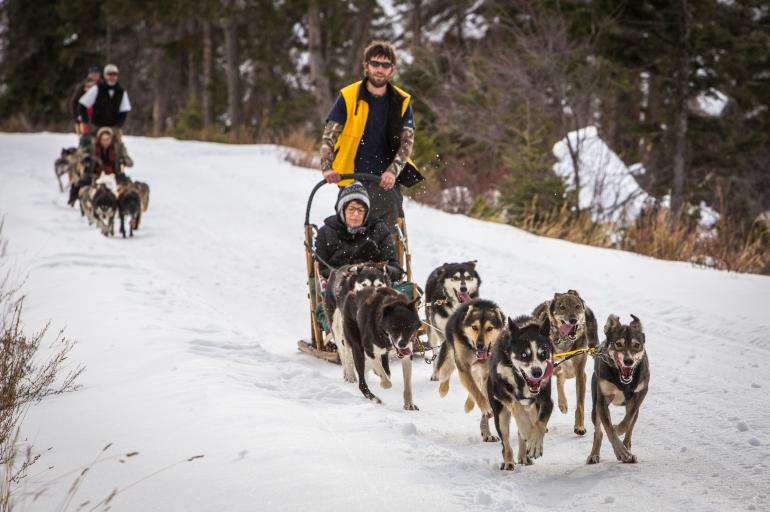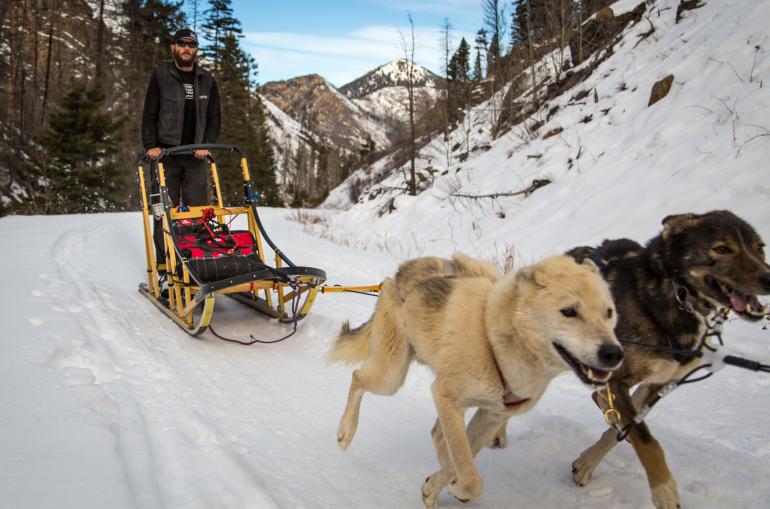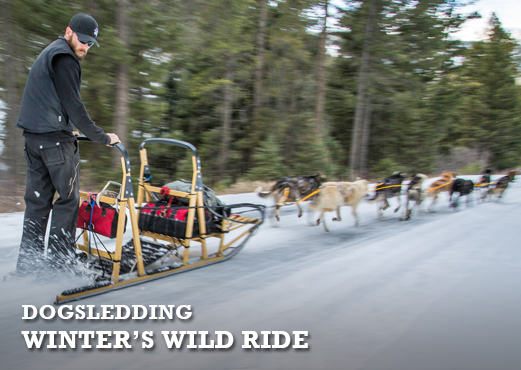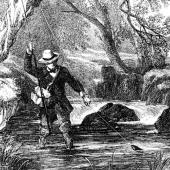Winter’s Wild Ride: Dogsledding
This efficiency of modern travel is a blessing and a curse. We have no issues reaching our destination, but the experience of our journey can be limited. In a place like Montana, getting there should be half the glory — the mountains and plains provide endless opportunity for visual drama, and all four seasons are rife with wildlife and scenery.
Reconnecting to the journey can be as easy as trying out an animal-powered mode of transportation. Notably, dogsledding.

Dogsledding is one of the oldest forms of animal-powered transportation, dating back thousands of years. Settlements in the open northern expanses of North America may not have been possible without canine power. Sled dogs were front and center during the Yukon gold rush in the late 1800s — the deciding factor between striking it rich and going home empty-handed could be determined by how strong a sled dog team you had.
Montana is no stranger to dogsledding. Each year since 1986, the 350-mile Montana Race to the Sky begins near Rimini and ends at Elk Park. This race attracts mushers from all over the world, and is a qualifying race for the 1,049-mile Iditarod in Alaska.
Montana’s landscape and lengthy winter provide an ideal setup for both leisurely and competitive dogsledding, making it a popular winter activity for tourists and locals alike. Dogsled operations are scattered all across Montana, with a busy location running right out of Chico Hot Springs in Paradise Valley. Hannah Vogel and her husband took over Absaroka Dogsled Treks just three years ago, though the operation has been operating out of Chico Hot Springs for 22 years. Weather permitting, they open the day after Thanksgiving and run straight through March.
Teams for guided tours are comprised of 6-12 dogs, and most operations have enough dogs for a half-dozen teams. The bigger teams run tandem sleds, which have space for both a guide and a guest driver. This is a common strategy for guest tours: the tandem sled acts almost like a driver’s education car, with two sets of brakes. Guests also have the option of driving a team on their own, but guides will be in every other sled to keep things running smoothly.
When the eager guests arrive, everyone meets at the office and layers up — it can get cold out on the trail! From there, it’s a crash course in mushing terms, safety pointers, and what to do in the off-chance that something goes wrong. After that, it’s meet the dogs, and head into the woods.
The harnessing process of a sled dog team can only be described as a joyous cacophony of howls and barks. The dogs know what’s coming, and they just can’t wait. But once they’re running, all is silent save for the sounds of paws and sled runners gliding over the snow. When these dogs get down to business, they do their job, and they do it well.

The majority of sled dogs are Alaskan Huskies. They weigh in at around 50 pounds, smaller than some people expect. Alaskan Huskies are not actually considered a breed, but more a “category” of dog — a highly specialized category though, bred to run and pull as efficiently as possible while working impeccably well as a team. Siberian Huskies are the other breed of dog used on a sled adventure. These are the poster-dogs for mushing. They are a little bigger, and have the distinctively mottled coat, stocky stature, and thick, curled tail.
Like any athlete, the dogs have to get in shape for their season. They live a leisurely life during the summer, and then in October, they start running in front of a four-wheeler to muscle up. From there, it’s only a matter of time before the snow falls and they’ll be back in their element, coursing over the snow, pulling a sled full of happy people.

Running a dog sled business is not as simple as exercising a pack of happy dogs. Getting a team to run well together takes a lot of work. Starting at about a year-and-a-half old, the young dogs train with the older, more confident dogs to learn the basics of working as a team. And just like you’d expect from your own canine companion, the personalities of these sled dogs runs the spectrum, from low-key to off-the-wall crazy.
The position-and-team combinations of the dogs depends both on individual personalities and physical attributes. Some dogs run well in all positions, from lead dog to wheel dog, while others prefer to stay in the middle of the pack. “The wheel dogs take the brute force of the sled,” say Vogel. “So we put our bigger dogs back there, where it’s more physically demanding.” The most mentally challenging position for the dogs is the lead dog, who must be in tune and following the voice commands of the musher.
The position of the dog also varies depending on locations and trail conditions. In fresh, heavy snow, the lead dogs also have the job of breaking the trail, so the mushers will put their larger dogs out front. And if the lead dog is having a bad day? No big deal, the musher or guide can hit the brakes during the trip and switch out the dogs’ positions to make it a great run for everyone.
Some dogs have a favorite spot, and there’s nothing anyone can do about it. “We have one dog who’s so sweet and wonderful, but she will not run up front,” says Vogel, laughing. “You put her in swing position, right behind the leader, and she’s great. You put her out front and she just stops.” On the other hand, some dogs need the constant stimulation of a new position, or they’ll get bored and chew lines or get distracted by squirrels.
The key is pairing and positioning the dogs where they will be happy, and that means constantly evaluating and watching the team to see how they run together and which dog performs best in which position. “We’ll usually pair a brain and a brawn up front,” says Vogel. “The brawn is the brute force to keep the line tight and prevent tangles, and the brain listens to turns and commands.”
Speed and strength are key components to matching the four-legged team members. If the lead is too fast, the team will get worn out, but if the lead dog is too slow, the lines will bunch up and get tangled. It’s all about bringing out the best in the dogs.
Maintaining organized lines is of utmost importance when it comes to keeping the dogs running smoothly. The gangline is the main line, running down between the dogs and attaching to the sled. The tug lines run onto the backs of the dogs’ harnesses, which is where the majority of the pulling power comes from. Necklines are only used to keep the dogs moving forward. These are run off the collar, but without any pulling pressure. Mushing is all voice command, and the lack of lines or reins in the musher’s hands can be a little nerve-wracking on a first outing. For some, having a foot brake is all it takes to relax. With a little pressure, the brake digs into the snow, similar to an ice pick. Full pressure is needed when stopped on the trail, which means standing with both feet on the brake. Since the brake works like an ice pick, semi-packed snow is ideal; tours won’t run if the trail is too icy.
Most people who head out on these tours have never gone dogsledding, but the tours make it easy, fun, and stress-free. The trails for guest tours are straightforward and safe, which means no hairpin turns or unexpected terrain. Absaroka Dogsled Treks takes guests up Mill Creek, where the thick trees shelter the trail from the wind while maintaining ample snow cover throughout the winter. Most companies offer several different distances — some outings as short as an hour, and some nearly 20 miles long, making for an all-day trip.
The biggest challenge that comes with running this type of business is being able to be flexible, since seasons are dependent on weather and trail conditions. An unseasonably warm or low-snow year will end up with a shorter seasons and canceled tours. Last year, the Vogels lost time and money because of the warm winter and below-average snowpack.
No matter where in Montana you find yourself, take a break from traveling by car, and hit a trail on a dogsled. “It’s such a connection to nature and the connection to the dogs,” says Vogel. “Seeing a creature so in its element is a powerful thing. If the whole world woke up with their attitudes, the world would be a different place.”
INTERESTED IN DOGSLEDDING IN MONTANA THIS WINTER?! Here are some great dogsledding adventures around Montana!
SPIRIT OF THE NORTH takes guests out by Moonlight Basin, with views of the Spanish Peaks and Big Sky. http://www.huskypower.com/
DOG SLED ADVENTURES MONTANA operates out of the Flathead Valley, with stunning Glacier National Park as the backdrop for their tours. http://www.dogsledadventuresmontana.com/
If you’re nearer to Yellowstone National Park than Glacier N.P., check out YELLOWSTONE DOG SLED ADVENTURES near West Yellowstone. www.YellowstoneDogSledAdventures.com












Leave a Comment Here